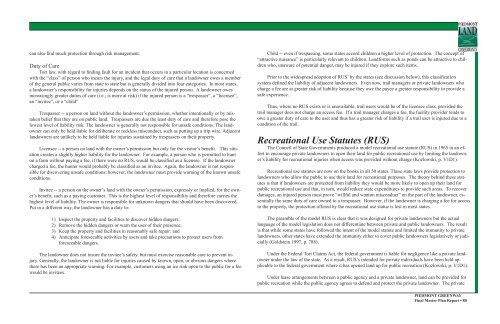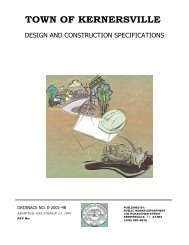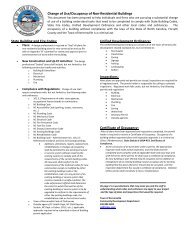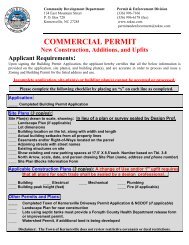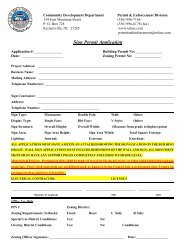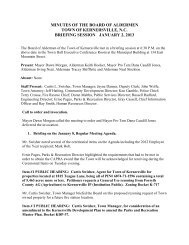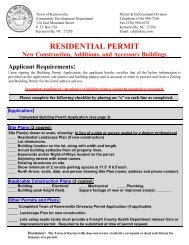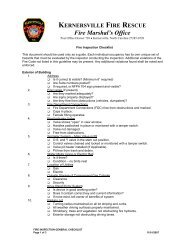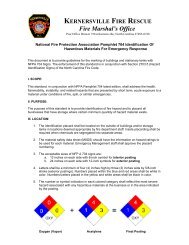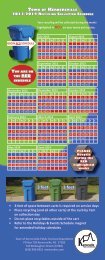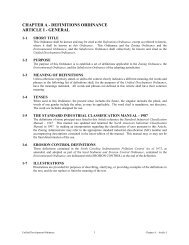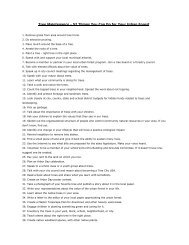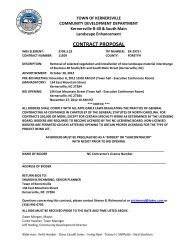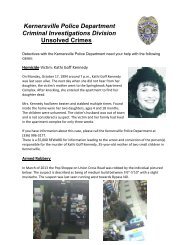Piedmont Greenway Master Plan - Town of Kernersville
Piedmont Greenway Master Plan - Town of Kernersville
Piedmont Greenway Master Plan - Town of Kernersville
- No tags were found...
Create successful ePaper yourself
Turn your PDF publications into a flip-book with our unique Google optimized e-Paper software.
can also find much protection through risk management.<br />
Duty <strong>of</strong> Care<br />
Tort law, with regard to finding fault for an incident that occurs in a particular location is concerned<br />
with the “class” <strong>of</strong> person who incurs the injury, and the legal duty <strong>of</strong> care that a landowner owes a member<br />
<strong>of</strong> the general public varies from state to state but is generally divided into four categories. In most states,<br />
a landowner’s responsibility for injuries depends on the status <strong>of</strong> the injured person. A landowner owes<br />
increasingly greater duties <strong>of</strong> care (i.e.; is more at risk) if the injured person is a “trespasser”, a “licensee”,<br />
an “invitee”, or a “child”.<br />
Trespasser -- a person on land without the landowner’s permission, whether intentionally or by mistaken<br />
belief that they are on public land. Trespassers are due the least duty <strong>of</strong> care and therefore pose the<br />
lowest level <strong>of</strong> liability risk. The landowner is generally not responsible for unsafe conditions. The landowner<br />
can only be held liable for deliberate or reckless misconduct, such as putting up a trip wire. Adjacent<br />
landowners are unlikely to be held liable for injuries sustained by trespassers on their property.<br />
Licensee -- a person on land with the owner’s permission but only for the visitor’s benefit. This situation<br />
creates a slightly higher liability for the landowner. For example, a person who is permitted to hunt<br />
on a farm without paying a fee, if there were no RUS, would be classified as a licensee. If the landowner<br />
charged a fee, the hunter would probably be classified as an invitee. Again, the landowner is not responsible<br />
for discovering unsafe conditions; however, the landowner must provide warning <strong>of</strong> the known unsafe<br />
conditions.<br />
Invitee -- a person on the owner’s land with the owner’s permission, expressly or implied, for the owner’s<br />
benefit, such as a paying customer. This is the highest level <strong>of</strong> responsibility and therefore carries the<br />
highest level <strong>of</strong> liability. The owner is responsible for unknown dangers that should have been discovered.<br />
Put in a different way, the landowner has a duty to:<br />
1) Inspect the property and facilities to discover hidden dangers;<br />
2) Remove the hidden dangers or warn the user <strong>of</strong> their presence;<br />
3) Keep the property and facilities in reasonably safe repair: and<br />
4) Anticipate foreseeable activities by users and take precautions to protect users from<br />
foreseeable dangers.<br />
The landowner does not insure the invitee’s safety, but must exercise reasonable care to prevent injury.<br />
Generally, the landowner is not liable for injuries caused by known, open, or obvious dangers where<br />
there has been an appropriate warning. For example, customers using an ice rink open to the public for a fee<br />
would be invitees.<br />
Child -- even if trespassing, some states accord children a higher level <strong>of</strong> protection. The concept <strong>of</strong><br />
“attractive nuisance” is particularly relevant to children. Landforms such as ponds can be attractive to children<br />
who, unaware <strong>of</strong> potential danger, may be injured if they explore such items.<br />
Prior to the widespread adoption <strong>of</strong> RUS’ by the states (see discussion below), this classification<br />
system defined the liability <strong>of</strong> adjacent landowners. Even now, trail managers or private landowners who<br />
charge a fee are at greater risk <strong>of</strong> liability because they owe the payee a greater responsibility to provide a<br />
safe experience.<br />
Thus, where no RUS exists or is unavailable, trail users would be <strong>of</strong> the licensee class, provided the<br />
trail manager does not charge an access fee. If a trail manager charges a fee, the facility provider tends to<br />
owe a greater duty <strong>of</strong> care to the user and thus has a greater risk <strong>of</strong> liability if a trail user is injured due to a<br />
condition <strong>of</strong> the trail.<br />
Recreational Use Statutes (RUS)<br />
The Council <strong>of</strong> State Governments produced a model recreational use statute (RUS) in 1965 in an effort<br />
to encourage private landowners to open their land for public recreational use by limiting the landowner’s<br />
liability for recreational injuries when access was provided without charge (Kozlowski, p. V1D1).<br />
Recreational use statutes are now on the books in all 50 states. These state laws provide protection to<br />
landowners who allow the public to use their land for recreational purposes. The theory behind these statutes<br />
is that if landowners are protected from liability they would be more likely to open up their land for<br />
public recreational use and that, in turn, would reduce state expenditures to provide such areas. To recover<br />
damages, an injured person must prove “willful and wanton misconduct” on the part <strong>of</strong> the landowner, essentially<br />
the same duty <strong>of</strong> care owned to a trespasser. However, if the landowner is charging a fee for access<br />
to the property, the protection <strong>of</strong>fered by the recreational use statue is lost in most states.<br />
The preamble <strong>of</strong> the model RUS is clear that it was designed for private landowners but the actual<br />
language <strong>of</strong> the model legislation does not differentiate between private and public landowners. The result<br />
is that while some states have followed the intent <strong>of</strong> the model statute and limited the immunity to private<br />
landowners, other states have extended the immunity either to cover public landowners legislatively or judicially<br />
(Goldstein 1997, p. 788).<br />
Under the Federal Tort Claims Act, the federal government is liable for negligence like a private landowner<br />
under the law <strong>of</strong> the state. As a result, RUS’s intended for private individuals have been held applicable<br />
to the federal government where it has opened land up for public recreation (Kozlowski, p. V1D1).<br />
Under lease arrangements between a public agency and a private landowner, land can be provided for<br />
public recreation while the public agency agrees to defend and protect the private landowner. The private<br />
PIEDMONT GREENWAY<br />
Final <strong>Master</strong> <strong>Plan</strong> Report • 80


